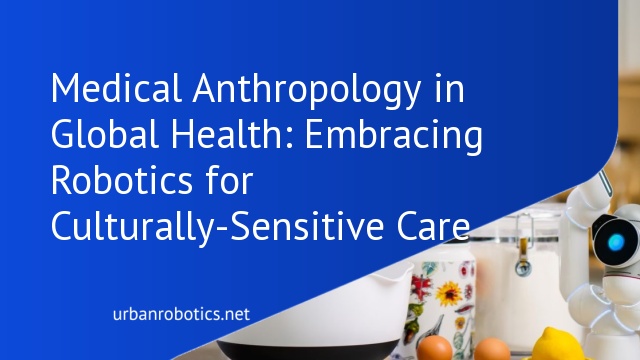Understanding Medical Anthropology
Medical anthropology studies how cultural beliefs and social practices impact health and illness. By examining these factors, we gain insights into how different communities view health care. This is crucial for developing health interventions that respect cultural contexts.
Key areas of medical anthropology include:
- Cultural Beliefs: Traditional healing practices, use of herbal remedies.
- Social Inequities: Health disparities due to socioeconomic status.
- Health Systems: Community health organizations, local health practices.
- Human Behaviors: Patient compliance, health-seeking behaviors.
When we integrate these insights into global health strategies, we create more effective interventions. Understanding cultural contexts ensures that robotic technologies in healthcare address real-world needs. This synergy between medical anthropology and robotics fosters sustainable, culturally-sensitive solutions.
The Intersection of Medical Anthropology and Global Health
Medical anthropology and global health intersect to enrich our understanding of health outcomes in diverse cultural contexts. This fusion leverages interdisciplinary insights to create more effective healthcare interventions.
Key Concepts in Global Health
Global health encompasses the study and improvement of health worldwide, focusing on health equity for all people. Central concepts include disease prevention, health promotion, and access to quality care. Addressing social determinants of health, like education and income, is crucial in this field. We recognize the importance of collaborations between nations and sectors to tackle health disparities and ensure sustainable improvements.
The Role of Medical Anthropology in Global Health
Medical anthropology studies the cultural and social factors influencing health. These factors include traditional healing practices, societal norms, and health systems. By incorporating these insights, we can design global health interventions that respect and utilize local knowledge. This cultural sensitivity ensures that healthcare initiatives are more acceptable and effective within specific communities, particularly when combined with advanced technologies like robotics.
Robotics in Healthcare: A New Frontier
Robotics is transforming healthcare by enhancing diagnostics, surgery, and patient care. It’s crucial to explore how these technologies integrate with medical anthropology to maximize benefits.
Innovations in Medical Robotics
Medical robots perform a variety of tasks, from assisting in surgeries to aiding in physical therapy. Surgical robots like the da Vinci system enable precision and minimally invasive procedures. Rehabilitation robots help patients regain motor skills through repetitive, guided exercises. Telepresence robots allow doctors to provide remote consultations, broadening access to medical expertise. These innovations showcase the potential for robotics to address diverse healthcare needs globally.
The Impact of Robotics on Healthcare Efficiency
Robotics increases healthcare efficiency primarily through reduced operation times and enhanced precision in procedures. Automated systems, such as robotic pharmacies, streamline medication dispensing processes, significantly cutting down errors and wait times. Robots like TUG handle logistics, transporting supplies within healthcare facilities, thus freeing up medical staff for patient care. By optimizing these logistic tasks, robotics contributes to more efficient, cost-effective healthcare delivery, improving overall patient outcomes.
Integrating Robotics with Medical Anthropology
Robots are transforming healthcare by bridging technological innovations and cultural considerations identified in medical anthropology. This integration offers robust solutions tailored to diverse global health challenges.
Case Studies of Robotic Applications in Global Health
Significant case studies demonstrate robotics’ impact on global health. In Rwanda, drone technology has revolutionized blood supply delivery, reducing transportation time from hours to minutes. In India, Swasthya Slate robots assist healthcare workers by performing diagnostic tests remotely. These examples highlight how incorporating robotics addresses unique regional health issues efficiently.
Challenges and Ethical Considerations
Integrating robotics and medical anthropology brings challenges and ethical concerns. Cultural acceptance of robots in medical roles varies; some communities might resist non-human caregivers. Data privacy issues also arise, as sensitive health information could be mishandled. Addressing these challenges requires collaboration between technologists and anthropologists to ensure solutions are culturally appropriate and ethically sound.
Future Directions
Exploring the synergy between medical anthropology and robotics paves the way for exciting advancements in global health.
Potential Developments In Medical Robotics
Innovations in AI and machine learning are expected to enhance robotic capabilities in diagnostics and surgery. MIT’s Medical Device Lab predicts autonomous robots performing multifaceted diagnostic tests, offering mobile health services in remote locations. Another promising development involves surgical robots offering precision that surpasses human capabilities. In Japan, robotic exoskeletons are aiding patient rehabilitation, demonstrating potential for global application. Integrating cultural competence into these technologies will ensure they address specific community needs effectively.
The Evolving Role of Medical Anthropology
Medical anthropology is playing a crucial role in shaping these advancements. By understanding cultural contexts, we can develop robotic solutions that are culturally acceptable and effective. Ethnographic research will continue to inform the design of healthcare technologies, ensuring they respect local health beliefs and practices. Furthermore, anthropologists will guide policymaking to align with ethical standards. This collaboration aims to address disparities in global health, leveraging robotics to improve outcomes while considering cultural sensitivities deeply embedded in various communities.
Conclusion
Our exploration into the intersection of medical anthropology and robotics in global health reveals a promising frontier. By integrating cultural insights with cutting-edge technology we can address health disparities more effectively. The potential of robotics to transform healthcare in underserved regions is immense but it requires a nuanced approach that respects cultural contexts.
As AI and machine learning continue to evolve the role of medical anthropology becomes even more critical. This collaboration ensures that technological advancements are not only innovative but also culturally competent. Together we can pave the way for a future where global health is equitable and inclusive leveraging the strengths of both fields.





